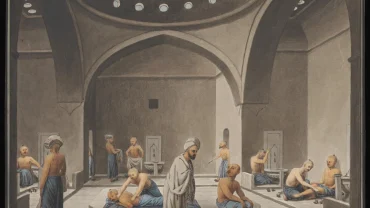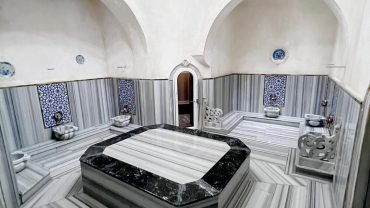What is a Hammam?
A hammam, also known as a Turkish bath, is a type of steam bath and social gathering place that has its roots in ancient Roman baths and holds significant cultural importance in the Islamic world. It became widespread, especially during the Ottoman Empire, and has since become a cultural heritage. Hammams typically consist of hot, warm, and cold rooms where people gather not only for cleansing but also for social activities. Istanbul is one of the cities that hosts the richest examples of this culture, with many historical and magnificent hammams.
History of the Hammam
Hammams are an adaptation of Roman baths to Islamic culture. After the fall of the Roman Empire, this bathing culture continued during the Byzantine Empire and spread with the rise of Islam to the Middle East and North Africa, and later to the Balkans and Anatolia through the Ottoman Empire. As the capital of the Ottoman Empire, Istanbul saw the construction of many historical and grand hammams. Structures like the Ayasofya Hammam and Çemberlitaş Hammam are beautiful examples of this period.
Benefits of the Hammam
Hammams are considered important not only for cleansing but also for their health and social benefits. Here are the main benefits of hammams:
- Detoxification: The hot air and steam help expel toxins from the body through sweat. Pores open up, allowing for deep cleansing. This process supports the body’s natural detoxification mechanisms and strengthens the immune system.
- Improved Blood Circulation: Moving between hot and cold rooms causes blood vessels to expand and contract, which enhances blood circulation and helps oxygenate the body more effectively. Good blood circulation ensures that organs and tissues function more efficiently, supporting overall health.
- Muscle Relaxation: The heat and steam in the hammam help relax muscles and reduce muscle pain. It is particularly effective in relieving muscle fatigue after sports. Regular hammam visits can reduce muscle spasms and improve mobility.
- Skin Health: The scrubbing and soaping processes in the hammam remove dead skin cells. This helps renew the skin, giving it a brighter and healthier appearance. Additionally, the hot steam opens pores, reducing blackheads and acne formation.
- Mental Relaxation: Hammams, with their quiet and peaceful environments, reduce stress. The hot water and steam calm the nervous system and provide mental relaxation. This process contributes to the reduction of stress and anxiety brought about by modern life. Time spent in a hammam offers an ideal environment for meditation and mindfulness.
- Social Bonds: Hammams are places where people come together and socialize. Especially during the Ottoman period, hammams were central to social events such as bridal baths before weddings. These social rituals reinforce the culture of solidarity and togetherness in the community.
Hammam Culture and Today
Today, hammams are popular venues for both locals and tourists. Even in modern cities, traditional hammams are preserved and offer visitors a historical experience. At the same time, modern hammams exist as part of spa and wellness centers. These modern hammams combine traditional elements with modern comfort and luxury, appealing to a broad clientele.
Some famous hammams in Istanbul include:
- Cemberlitas Hammam: Built by Mimar Sinan in 1584, this is one of Istanbul’s oldest and most popular hammams.
- Haseki Hürrem Sultan Hammam: Located between Ayasofya and Sultanahmet Mosque, this hammam was commissioned by Hürrem Sultan, the wife of Sultan Suleiman the Magnificent.
- Cağaloğlu Hammam: Built in 1741, this hammam is a beautiful example of baroque and classical Ottoman architecture and is very popular among tourists.
What to Do in a Hammam
Following certain steps is important during a hammam visit. Here’s what to do in a hammam:
- Preparation: Before going to the hammam, it’s important to eat lightly and drink plenty of water. This helps your body better adjust to the heat and steam.
- Entrance and Warming Up: First, enter the hot room and let your body warm up. This process can take about 15-20 minutes.
- Scrubbing and Soaping: Once your body is adequately warmed, you can proceed with the scrubbing and soaping processes. These procedures help remove dead skin cells and cleanse the skin.
- Resting: After scrubbing, it’s important to rest in the warm room and allow your body to relax.
- Cooling Down: Finally, spend a few minutes in the cold room to help your body return to its normal temperature. This step regulates blood circulation and revitalizes the body.
Hammams hold significant cultural and historical importance and offer health and social benefits. The hot air, steam, and traditional cleansing rituals provide both physical and mental rejuvenation. In cities like Istanbul, it’s possible to experience this unique tradition by visiting historical hammams. The hammam culture, serving as a bridge from the past to the present, continues to be a part of both traditional and modern life. Traditional hammam rituals, combined with modern health and wellness practices, offer visitors a unique experience. Thus, hammam visits stand out as an indispensable activity for both locals and tourists.





Comment (0)